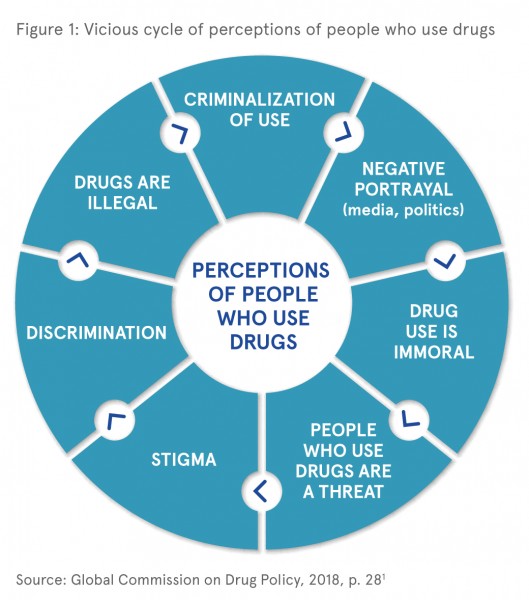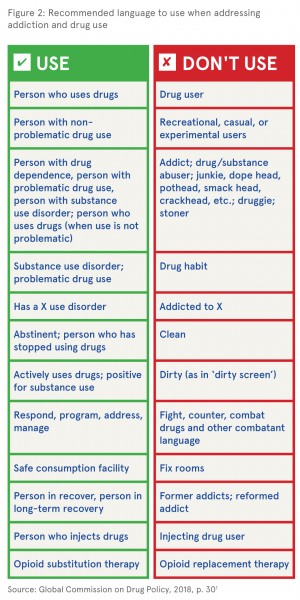Dillon, Lucy (2018) Challenging prejudice and changing language. Drugnet Ireland, Issue 65, Spring 2018, pp. 4-5.
| Preview | Title | Contact |
|---|---|---|
|
PDF (Drugnet Ireland, Issue 65 Spring 2018)
2MB |
The world drug perception problem: countering prejudices about people who use drugs1 challenges common public perceptions of addiction, drugs, and the people who use them. It highlights the importance of language in creating and reducing stigma and discrimination. The report is by the Global Commission on Drug Policy (GCDP), which describes itself as made up of political leaders and leading thinkers from across the political spectrum. It sets out to ‘bring to the international level an informed, science-based discussion about humane and effective ways to reduce the harm caused by drugs to people and societies’.2 Since its inception, the GCDP has published a series of reports that are ‘technical and political reports to ground evidence-based policy recommendations in human rights, health and development’.2 The current report was published in January 2018.
Misconceptions
Based on earlier reports by the GCDP,3‒7 the authors start from the premise that ‘the potential harms of drugs for people and communities are exacerbated by repressive drug control policies at local, national and international levels’ (p. 7). At its core, the current report argues that drug policy development and reform should be based on evidence and factual discussions, instead of being frequently characterised by moral debates based on perceptions rather than facts. The main body of the report explores commonly held perceptions and fears about drugs and the people who use them. It then compares them with the evidence available and recommends changes that could be enacted to make more effective drug policies. In general, this involves a move away from a prohibitionist approach. A detailed summary of the report is beyond the scope of this article, but a few of the perceptions challenged are outlined below:
- Drugs are often perceived to be ‘unnatural contaminants, pushed into a society from the outside or by deviant forces’ (p. 7). However, using mind-altering substances is an almost universal activity across cultures. What varies is the cultural acceptability of specific substances; while alcohol use may be an acceptable part of social activity in some parts of the world, in others it is demonised and prohibited. The authors reiterate the finding that the ‘legal status of a drug does not systematically relate to its potential harm’ (p. 11). They argue that by making a drug illegal its potential harms are increased for the user.
- There is a widely held belief that if a person uses certain drugs, they will almost inevitably end up dependent on that drug. The authors highlight that while illegal drug use is relatively common, only an estimated 11.6% of those who use are considered to be problematic users or have an addiction: ‘The most common pattern of the use of psychoactive substances is episodic and non-problematic’ (p. 14).
- There is a common perception that people who use drugs engage in criminal activities. This is, of course, the case where the drugs and their use are illegal. The vast majority of people who use illegal drugs are not involved in any criminal activity, other than their purchase and use. The authors also argue that other linkages between drugs and crime are a result of the prohibition framework. For example, the cost of accessing a drug increases when it is made illegal, and this has been found to increase levels of criminal activity among people who use.
Language and stigma
The media is shown to have a strong influence on how the public perceives drugs, the people who use them, and related issues. The authors argue that media portrayals are overwhelmingly negative and focus on two narratives: the first links drugs with crime; the second that drug use will inevitably result in ‘devastating’ consequences for the user and their immediate environment (p. 26). Both of these, coupled with the extensive use of negative language when reporting on these issues, create an environment in which drugs and the people who use them are heavily stigmatised and discriminated against (see Figure 1). Indeed, the authors argue that no medical condition is more stigmatised than ‘addiction’ (p. 27). The language used dehumanises and alienates people who use drugs from the rest of society, thereby identifying them as ‘others’ for whom society does not have a responsibility to help. It reinforces the misconception that drug use stems from a problem with the individual rather than society as a whole. The impact of this is that the health needs of people who use drugs are not prioritised by society, resulting in a lack of appropriate services. Even where services do exist, people who experience stigma are less likely to identify themselves to services. They argue for a shift in the language used when reporting on drug-related issues (see Figure 2).


Recommendations
The authors make six recommendations structured around stakeholders, who they believe have a strong influence on how drug policy is shaped. They argue that changing people’s perceptions of drugs and the people who use them will reduce stigma and discrimination and will contribute to an environment in which drug policy reform is driven by facts rather than moral beliefs. The recommendations are:
- Policymakers must aim to change current perceptions of drugs and the people who use them by providing reliable and consistent information. Their public policy decisions should be evidence based, and they should maintain their position even when it is not in line with public opinion that is grounded in a moral view rather than facts.
- Opinion leaders, such as the media, religious leaders and celebrities, must be responsible in shaping public opinions and perceptions on drugs. They should promote the use of non-stigmatising and non-discriminatory language about drugs and their users.
- Ordinary citizens need to act as advocates by taking part in the debate about drug policy reform; sustaining activism and advocacy; and keeping governments and other public representatives, as well as the media and health and social care professionals, accountable.
- Agents of law enforcement (including the police and members of the judiciary) need to stop acts of harassment based on negative perceptions of people who use drugs. The incarceration of people who need medical and social support needs to be addressed.
- The medical community and healthcare professionals need to be vocal in promoting evidence-based prevention, treatment, and harm reduction services so that health and safety are prioritised. They need to urgently address ‘perception-based stigma’ (p. 37) in healthcare settings.
- The 2019 UN Commission on Narcotic Drugs’ ministerial segment provides an opportunity to review the use of language in international documents and negotiations. This needs to be acted upon.
1 Global Commission on Drug Policy (2018) The world drug perception problem: countering prejudices about people who use drugs. Geneva: Global Commission on Drug Policy. http://www.drugsandalcohol.ie/28434/
2 For more information on the GCDP, visit: http://www.globalcommissionondrugs.org/
3 GCDP (2011) War on drugs. Geneva: GCDP. http://www.drugsandalcohol.ie/28476/
4 GCDP (2012) The war on drugs and HIV/AIDS: how the criminalization of drug use fuels the global pandemic. Geneva: GCDP. http://www.drugsandalcohol.ie/28477/
5 GCDP (2013) The negative impact of the war on drugs on public health: the hidden hepatitis C epidemic. Geneva: GCDP. http://www.drugsandalcohol.ie/28474/
6 GCDP (2015) The negative impact of drug control on public health: the global crisis of avoidable pain. Geneva: GCDP. http://www.drugsandalcohol.ie/28475/
7 GCDP (2016) Advancing drug policy reform: a new approach to decriminalization. Geneva: GCDP. http://www.drugsandalcohol.ie/26410/
MA-ML Social science, culture and community > Sociocultural aspects of substance use > Societal attitude toward substance use / public opinion
MA-ML Social science, culture and community > Sociocultural discrimination > Prejudice (stigma / discrimination)
VA Geographic area > International
VA Geographic area > Europe > Ireland
Repository Staff Only: item control page